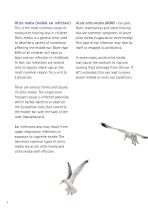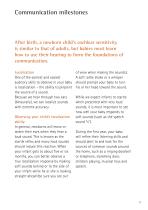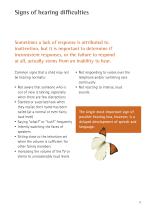
Catalog excerpts

Children's hearing
Open the catalog to page 1
Content Building the future How we hear Children’s hearing loss Communication milestones Signs of hearing difficulties Indicators and prevention of hearing loss What to do if you think your child may have a hearing loss? Types of audiological evaluations Hearing Amplification Where to get help
Open the catalog to page 2
Children are our future. By giving them access to the wealth of sounds that enrich today’s world, we can help them to develop the auditory skills they need to build their future. Phonak has been committed to providing high-tech solutions for children with hearing loss for over 40 years. Innovative technology has enabled us to successfully meet growing needs. Many of the developments in the field of pediatrics have led the way for the progress of Phonak hearing solutions in general. The trail of innovation continues and it remains a priority at Phonak to help prepare today’s children for...
Open the catalog to page 3
Understanding the basic anatomy and function of the ear will help you identify conditions that can affect your child’s hearing. The human ear has three main sections, which consist of the outer ear, the middle ear and the inner ear. The outer ear The outer ear consists of the auricle, also called the pinna. The pinna collects and channels sound into the external ear canal (auditory canal). The ear canal amplifies the sound waves and further funnels them toward the eardrum (tympanic membrane). The middle ear The eardrum vibrates in response to the movements of sound waves entering the ear...
Open the catalog to page 4
Anatomy of the ear Pinna Stapes Malleus Semicircular canals Auditory canal Eustachian tube Auditory nerve
Open the catalog to page 5
Children’s hearing loss There are conditions that may occur before birth, during infancy or in childhood that may affect a child’s ability to hear normally. Essentially, there are two types of hearing loss: conductive and sensorineural. Conductive hearing loss (medically treatable conditions) With a conductive hearing loss, the inner ear functions normally, but something affects the outer or middle ear, hindering sound from reaching the inner ear. Conductive hearing losses are mild to moderate in degree and are usually temporary and treatable. You can simulate a conductive hearing loss by...
Open the catalog to page 7
Otitis media (middle ear infection) This is the most common cause of conductive hearing loss in children. Otitis media is a general term used to describe a variety of conditions affecting the middle ear. More than 85% of all children will have at least one ear infection in childhood. In fact, ear infections are second only to regular check-ups as the most common reason for a visit to a physician. There are various forms and causes of otitis media. The single most frequent cause is infected adenoids, which harbor bacteria or obstruct the Eustachian tube that connects the middle ear with the...
Open the catalog to page 8
Otitis media with effusion (OME) – frequently follows an episode of acute otitis media. OME occurs when fluid remains in the middle ear, impeding eardrum vibrations and middle ear bone movement. This can cause mild to moderate degrees of hearing loss. In very young children, this hearing loss may hinder spoken language development. The treatment of otitis media with effusion is controversial. Sometimes the infection heals on its own or with the help of antibiotics or myringotomy to drain the fluid, and other times it resists these conventional approaches. If the infection persists and...
Open the catalog to page 9
Sensorineural hearing loss Sensorineural hearing loss is caused by dysfunction of the cochlea (sensory) or auditory pathways to the brain (neural) and often is present from birth. It can also develop as a result of noise exposure, age or exposure to ototoxic medication (medicines that can damage hearing). Sensorineural hearing losses can range from mild to profound and may affect all or only certain frequency ranges. Mixed hearing loss Sometimes a combination of factors occur that affect both the outer or middle ear and the inner ear (cochlea), resulting in a mixed hearing loss....
Open the catalog to page 10
The cochlea, which is the sensory organ of hearing, attains full adult size and enables a child to hear by the 20th week of pregnancy. This means the child can be exposed to voices, such as its mother's, even before he or she is born.
Open the catalog to page 12
Communication milestones After birth, a newborn child’s cochlear sensitivity is similar to that of adults, but babies must learn how to use their hearing to form the foundations of communication. Localization One of the earliest and easiest auditory skills to observe in your baby is localization – the ability to pinpoint the source of a sound. Because we hear through two ears (binaurally), we can localize sounds with extreme accuracy. Observing your child’s localization ability In general, newborns will move or widen their eyes when they hear a loud sound. This is known as the startle...
Open the catalog to page 13
Your child’s speech and language development milestones 9 months Demonstrates an understanding of simple words such as “mommy,“ “daddy,“ “no,“ “bye-bye.“ 10 months Babbling should sound “speech like,” with single syllables strung together (“da-da-dada”). The first recognizable words emerge around this time. 1 year One or more real words spoken. 3 to 5 years Spoken language should be used constantly to express wants, reflect emotions, convey information and ask questions. A preschooler should understand nearly all that is said. Spoken vocabulary grows from 1,000 to 2,000 words, which are...
Open the catalog to page 14
Signs of hearing difficulties Sometimes a lack of response is attributed to inattention, but it is important to determine if inconsistent responses, or the failure to respond at all, actually stems from an inability to hear. Common signs that a child may not be hearing normally: Not aware that someone who is out of view is talking, especially when there are few distractions Startled or surprised look when they realize their name has been called (at a normal or even fairly loud level) Saying “what?“ or “huh?“ frequently Intently watching the faces of speakers Sitting close to the television...
Open the catalog to page 15All Phonak catalogs and technical brochures
-
Phonak Power Pack
1 Pages
-
Phonak Mini Charger Case
1 Pages
-
Phonak Charger Case Combi
1 Pages
-
Phonak Audéo M-312
2 Pages
-
Phonak Audéo M
2 Pages
-
Phonak AudéoTM B
6 Pages
-
Phonak AudéoTM Marvel
8 Pages
-
Phonak pediatric solutions
42 Pages
-
Audéo MINI
2 Pages
-
CROS
2 Pages
-
Naída Q
9 Pages
Archived catalogs
-
Phonak Sky V
3 Pages
-
Phonak Sky V
8 Pages
-
brochure phonak CROS II
9 Pages
-
MicroLink™ Freedom
2 Pages
-
Nios S H2O
2 Pages
-
Naída S III
2 Pages
-
Naída S V
2 Pages
-
Naída S IX
2 Pages
-
Cassia
6 Pages
-
Solana
6 Pages
-
Phonak Audéo V
7 Pages
-
Phonak Dalia
2 Pages
-
Pamphlet Phonak Virto Q
9 Pages
-
Pamphlet Phonak Bolero Q
9 Pages
-
Phonak Audéo Q
9 Pages
-
Consumer Flyer Audéo S V
2 Pages
-
Consumer Flyer Audéo S IX
2 Pages
-
Product Information Audéo S
6 Pages
-
Brochure Audéo S
24 Pages
-
Consumer Flyer M H2O
2 Pages
-
Consumer Flyer Phonak nano
2 Pages
-
Consumer Flyer Phonak Ambra
2 Pages
-
Brochure Phonak Ambra
32 Pages
-
Datasheet Lyric2
2 Pages
-
Product Information Lyric2
2 Pages
-
Datasheet Phonak Bolero Q-SP
2 Pages
-
Datasheet Phonak Bolero Q-P
2 Pages
-
Phonak Bolero Q
6 Pages



















































